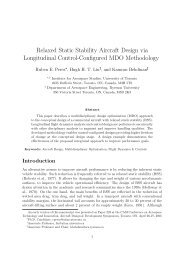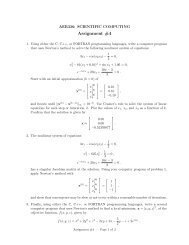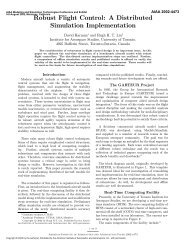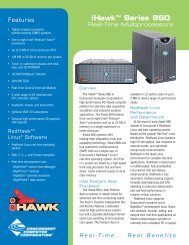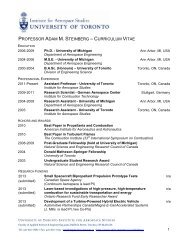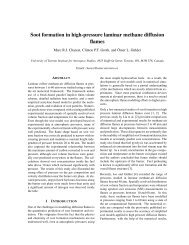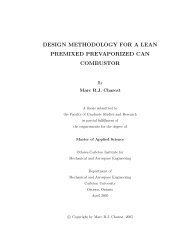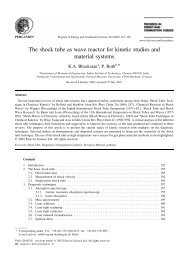Fluid Flow and Thermodynamic Analysis of a Wing Anti-Icing System
Fluid Flow and Thermodynamic Analysis of a Wing Anti-Icing System
Fluid Flow and Thermodynamic Analysis of a Wing Anti-Icing System
Create successful ePaper yourself
Turn your PDF publications into a flip-book with our unique Google optimized e-Paper software.
Vol. 51, No. 1, March 2005 Vol. 51, no 1, mars 2005<br />
<strong>Fluid</strong> <strong>Flow</strong> <strong>and</strong> <strong>Thermodynamic</strong> <strong>Analysis</strong> <strong>of</strong> a<br />
<strong>Wing</strong> <strong>Anti</strong>-<strong>Icing</strong> <strong>System</strong><br />
Jun Hua * Hugh H.T. Liu *<br />
ABSTRACT<br />
In this paper, a Navier-Stokes analysis is presented for a<br />
thermal aircraft wing anti-icing system. A threedimensional<br />
(3-D) wing leading edge bay model <strong>and</strong> its<br />
two-dimensional (2-D) bay-slice approximation models are<br />
simulated using computational fluid dynamics (CFD). The<br />
numerical results <strong>and</strong> their comparative study address the<br />
2-D approximation for the benefit <strong>of</strong> computational<br />
efficiency. Furthermore, the bay skin temperature<br />
distributions are obtained by an integrated interior–exterior<br />
thermodynamic analysis. It takes into account the skin heat<br />
transfer <strong>and</strong> conductivity. The 2-D CFD results may<br />
overestimate the heat transfer, but the surface temperature<br />
near the wing leading edge is within the flight test data<br />
range.<br />
RÉSUMÉ<br />
Dans le présent document, une analyse Navier-Stokes<br />
est présentée pour un système antigivrage thermique de<br />
voilure d’aéronef. Un modèle de bord d’attaque de voilure<br />
en trois dimensions (3D) et des modèles d’approximation<br />
de pr<strong>of</strong>il en deux dimensions (2D) sont simulés au moyen<br />
de la simulation numérique de la dynamique de fluides<br />
(CFD). Les résultats numériques et leur étude comparative<br />
traitent de l’approximation en deux dimensions pour le<br />
bénéfice de l’efficacité numérique. De plus, la distribution<br />
des températures sur le revêtement est obtenue par une<br />
analyse thermodynamique intégrée intérieur-extérieur.<br />
Elle prend en compte le transfert de chaleur au revêtement<br />
et la conductibilité. Les résultats CFD à deux dimensions<br />
peuvent surestimer le transfert de chaleur, mais la<br />
température superficielle près du bord d’attaque de la<br />
voilure s’inscrit dans la plage des données d’essai en vol.<br />
* Institute for Aerospace Studies<br />
University <strong>of</strong> Toronto<br />
4925 Dufferin Street<br />
Toronto, ON M3H 5T6, Canada<br />
E-mail: liu@utias.utoronto.ca<br />
Received 26 August 2003.<br />
1. INTRODUCTION<br />
The thermal anti-icing system is installed on most passenger<br />
airplanes. It introduces hot bleeding air from the power<br />
plant into the wing leading edge, to keep the skin surface<br />
temperature above the icing condition. The wing surface<br />
temperature is controlled through regulating the hot flow<br />
passing a wing anti-icing valve by an automatic control system.<br />
Recently, the University <strong>of</strong> Toronto Institute for Aerospace<br />
Studies (UTIAS) initiated a research project in this area for the<br />
wing anti-icing control system development <strong>and</strong> analysis. At<br />
the initial stage, our investigation focuses on the skin<br />
temperature prediction model development. In this paper, we<br />
present our research work <strong>of</strong> the model analysis using the CFD<br />
methods <strong>and</strong> tools.<br />
Compared with conventional analytical methods (Frick <strong>and</strong><br />
McCullough, 1942), the most recent anti-icing research efforts<br />
have focused on using the CFD technique (Bourgault et al.,<br />
2000; Beaugendre et al., 2003; Morency et al., 1999; de Mattos<br />
<strong>and</strong> Oliveira, 2000; Wang et al., 2003) <strong>and</strong> have demonstrated<br />
its strong potential. The main purpose <strong>of</strong> this paper is to apply<br />
the existing CFD tools to assist the system modeling <strong>and</strong><br />
simulation analysis, especially the skin temperature<br />
distributions. Therefore, the CFD analysis presented in this<br />
paper mainly consists <strong>of</strong> two steps:<br />
(1) A 2-D bay-slice thermal model is proposed to represent the<br />
3-D physical bay <strong>of</strong> the wing section, for the benefit <strong>of</strong><br />
computational efficiency. To evaluate the 2-D slice<br />
approximation, this paper presents the investigation <strong>of</strong><br />
fluid analysis for both a 3-D bay model <strong>and</strong> its 2-D slice<br />
approximation model, as well as the comparison <strong>of</strong> the<br />
detailed flow fields inside a 3-D wing leading edge bay<br />
with that <strong>of</strong> the corresponding 2-D slice bay sections.<br />
(2) To predict the bay skin temperature distributions more<br />
accurately, this paper further provides thermal flow<br />
characteristics <strong>and</strong> temperature values both inside <strong>and</strong><br />
outside the leading edge bay. Skin conditions with heat<br />
transfer <strong>and</strong> conductivity are taken into account in an<br />
integrated interior–exterior thermodynamic analysis. As a<br />
result, the wing leading-edge skin temperature<br />
distributions are presented in responding to certain flight<br />
conditions <strong>and</strong> the hot air inlet configurations.<br />
The remaining part <strong>of</strong> this paper is organized as follows. In<br />
Sect. 2, the 3-D bay model <strong>and</strong> its 2-D slice approximation<br />
© 2005 CASI 35
Canadian Aeronautics <strong>and</strong> Space Journal<br />
Journal aéronautique et spatial du Canada<br />
models are simulated. Their numerical results are compared<br />
<strong>and</strong> evaluated. In Sect. 3, the integrated interior–exterior<br />
thermal <strong>and</strong> flow analysis is presented. Finally, the concluding<br />
remarks are <strong>of</strong>fered in Sect. 4.<br />
2. FLOW FIELD ANALYSIS FOR A BAY MODEL<br />
2.1. The Three-Dimensional Bay Model<br />
The thermal anti-icing system introduces the hot bleeding<br />
air into a piccolo tube inside the leading edge <strong>of</strong> the wing. The<br />
hot air then injects from the small holes on the piccolo tube <strong>and</strong><br />
impinges the inner surface <strong>of</strong> the leading edge skin to heat it.<br />
The outer surface <strong>of</strong> the skin is then kept at a certain<br />
temperature high enough for anti-icing or de-icing operations.<br />
Along the wingspan inside the leading edge, there are normally<br />
a number <strong>of</strong> ribs to configure the contours <strong>of</strong> the skin <strong>and</strong> to<br />
support the piccolo tube. These ribs then form a number <strong>of</strong><br />
span-wise segments; these are called bays. The hot air inside<br />
the bays exits either from exhaust hoses or through certain<br />
exhaust collection systems. The most important characteristics<br />
to us are the surface temperature distributions. The flow<br />
structure inside the bay is important for the heat transfer, <strong>and</strong><br />
the global thermal efficiency η, defined below, is a major<br />
measure <strong>of</strong> the efficiency <strong>of</strong> the system:<br />
η= ( T −T )/( T −T<br />
)<br />
inlet exhaust inlet external<br />
where T inlet represents the temperature inside the piccolo tube,<br />
T exhaust is the temperature at bay exhaust holes, <strong>and</strong> T external is<br />
the temperature at the flight altitude.<br />
A 3-D bay model is defined as one span segment <strong>of</strong> the wing<br />
leading edge anti-icing bay (Figure 1). It consists <strong>of</strong> the<br />
following: (1) a piccolo tube with a number <strong>of</strong> small holes to let<br />
the hot air impinge onto the leading edge. The small holes are in<br />
two rows in angles <strong>of</strong> 15° upper <strong>and</strong> lower from the wing chord<br />
plane; (2) the leading edge skin to be heated by the hot air in the<br />
anti-icing operation; (3) the exhaust holes on the lower side <strong>of</strong><br />
the bay to allow the hot air to exit to the exterior flow; (4) two<br />
ribs (side walls) to separate the bays, with the hoses on the ribs<br />
neglected; <strong>and</strong> (5) the heat shield serving as the back wall <strong>of</strong> the<br />
bay model. The diameter <strong>of</strong> the piccolo tube remains constant<br />
even though the bay itself is slightly tapered.<br />
2.2. The Numerical Approach<br />
The CFD analysis tool used in this research is a well-known<br />
commercial Navier-Stokes solver Fluent V6.0 (Fluent V6.0,<br />
2002). Its reliability has been demonstrated by a large number<br />
<strong>of</strong> aerospace <strong>and</strong> industrial applications.<br />
An unstructured grid is used because <strong>of</strong> the complexity <strong>of</strong><br />
the 3-D configuration. There are 281 980 nodes in the 3-D<br />
mesh <strong>and</strong> 21 330 nodes in the 2-D slice grid. Mesh adaption<br />
based on turbulent intensity is tested in 2-D simulations, but the<br />
Figure 1. Three-dimensaionl bay model with two exhaust holes (the<br />
skin <strong>and</strong> heat shield shown by wires).<br />
results are found to be quite similar, as the original mesh is<br />
already fine enough. In the integrated interior–exterior thermal<br />
flow analysis, structured mesh is used. Details will be given<br />
later.<br />
One- <strong>and</strong> two-equation turbulent models are tested for the<br />
viscous flow simulation, <strong>and</strong> the RNG k- Model, based on the<br />
renormalization group method, is selected because <strong>of</strong> its<br />
strength in simulating highly curved flows <strong>and</strong> wall heat<br />
transfers. Because the flow becomes compressible, the secondorder<br />
upwind schemes are used in both 2-D <strong>and</strong> 3-D<br />
calculations.<br />
Pressure inlet <strong>and</strong> outlet conditions are used at the piccolo<br />
tube holes <strong>and</strong> the exhaust holes. The turbulent specification<br />
methods at the inlet boundary are the intensity <strong>and</strong> the<br />
hydraulic diameter, reflecting the size <strong>of</strong> the small holes. For<br />
the bay internal flow simulation, the inlet <strong>and</strong> outlet conditions<br />
are selected based on the flight test measurements (Bombardier<br />
Aerospace, 2002). 1 For example, one inlet condition is P =<br />
90 000 Pa, T = 453 K in the Piccolo tube, while the outlet<br />
condition is P = 63 000 Pa <strong>and</strong> T = 343 K at the exhaust holes <strong>of</strong><br />
the bay.<br />
2.3. The Numerical Results<br />
Figure 2 shows the velocity vectors colored by the velocity<br />
magnitude (m/s), injecting from the piccolo tube holes, flowing<br />
over the inner skin <strong>and</strong> the piccolo tube surfaces <strong>and</strong> draining<br />
through the exhaust holes.<br />
Figure 3 plots part <strong>of</strong> the streamlines inside the bay. The<br />
flow in the lower part <strong>of</strong> the bay is mainly chord-wise <strong>and</strong> has<br />
higher speed. Mixed 3-D flow could be seen in the upper part <strong>of</strong><br />
the bay, <strong>and</strong> clear cross flow exists near the upper-rear corner <strong>of</strong><br />
the bay. However, because <strong>of</strong> the very small magnitude <strong>of</strong> the<br />
cross flow velocity, it may not significantly affect the values <strong>of</strong><br />
the flow characteristics, such as the pressure <strong>and</strong> the<br />
temperature in the span direction there.<br />
<strong>Flow</strong> characteristics are examined to investigate the<br />
inference <strong>of</strong> the 3-D effects. Figure 4 shows the skin friction<br />
coefficient C f distributions. It is observed that the skin friction<br />
in the front leading edge is strong. The lower surface transfer is<br />
1 Please note that all flight test data presented in this paper are representative only to an actual airplane with a similar anti-icing system, exact<br />
design configurations are not provided. The bay model in this paper is generated according to the plots <strong>of</strong> the system so the geometry data<br />
may not necessarily be exact.<br />
36 © 2005 CASI
Vol. 51, No. 1, March 2005 Vol. 51, no 1, mars 2005<br />
Figure 2. Velocity vectors (m/s).<br />
exhaust holes are modified into slots, the width <strong>of</strong> which is<br />
chosen to match the total injection <strong>and</strong> exhaust areas <strong>of</strong> the 3-D<br />
bay.<br />
<strong>Flow</strong> parameters, such as velocity V(m/s), Mach number M,<br />
the respective total <strong>and</strong> static pressures P 0 <strong>and</strong> P (Pa), the total<br />
<strong>and</strong> static temperatures T 0 <strong>and</strong> T (K), the skin friction<br />
coefficient C f from both 2-D <strong>and</strong> 3-D computations, are also<br />
examined <strong>and</strong> compared, to further investigate the slice<br />
approximation.<br />
The streamlines <strong>of</strong> a 3-D section are compared with those <strong>of</strong><br />
a 2-D slice in Figure 5. Both sections have a lower 15°<br />
injection, with the exception that an exhaust slot exists in the 2-<br />
D model. The injecting flow between the piccolo tube <strong>and</strong> the<br />
leading edge could be seen in both 2-D <strong>and</strong> 3-D sections. The<br />
large vortex in the lower part <strong>of</strong> the bay behind the piccolo tube<br />
exists in both sections. The other large vortex in the upper rear<br />
part <strong>of</strong> the 2-D field does not appear clearly in the 3-D section<br />
because <strong>of</strong> the dominant mixed <strong>and</strong> cross flow.<br />
Figure 3. Part <strong>of</strong> the streamlines inside the bay (colored by velocity<br />
magnitude (m/s)).<br />
Figure 4. Skin friction coefficient distributions <strong>of</strong> the inner surface <strong>of</strong><br />
the 3-D bay.<br />
chord-wise dominant. And the upper surface exchange is weak<br />
but roughly uniform.<br />
2.4. Comparison <strong>of</strong> the Two- <strong>and</strong> Three-Dimensional<br />
<strong>Flow</strong> Fields<br />
To evaluate the slice approximation assumption, 2-D slices<br />
are computed separately <strong>and</strong> compared with the flow fields <strong>of</strong> a<br />
couple <strong>of</strong> span sections <strong>of</strong> the 3-D bay, for example, the cross<br />
sections with <strong>and</strong> without injection holes, <strong>and</strong> those with <strong>and</strong><br />
without exhaust holes. In the 2-D slice model, the injection <strong>and</strong><br />
Figure 5. Comparison <strong>of</strong> flow fields colored by Mach number: (a) one<br />
cross section in 3-D bay; (b) corresponding 2-D slice.<br />
However, the 3-D skin friction coefficient C f appears as low<br />
as only approximately 1/2 to 1/3 the values <strong>of</strong> the<br />
corresponding 2-D computations for the lower surface <strong>and</strong> only<br />
1/10 the values for the upper surface. The only exception is<br />
located at the leading edge area where the hot air impinges the<br />
internal skin surface, where the 2-D <strong>and</strong> 3-D values are close.<br />
The reason <strong>of</strong> this 2-D to 3-D discrepancy lies in the difference<br />
<strong>of</strong> the local flow speed, as discussed before. The 2-D flow<br />
© 2005 CASI 37
Canadian Aeronautics <strong>and</strong> Space Journal<br />
Journal aéronautique et spatial du Canada<br />
speed near the inner upper surface is higher than the 3-D<br />
values. This phenomenon suggests that the heat transfer might<br />
be over-estimated in 2-D results, particularly at the upper<br />
surface. Therefore, special attention should be given when one<br />
chooses the 2-D approximation model. Data tuning, correction,<br />
<strong>and</strong> validation are necessary when estimating the 3-D bay flows<br />
using the 2-D results.<br />
3. FLOW AND THERMAL ANALYSIS OF THE<br />
INTEGRATED INTERIOR–EXTERIOR FLOWS<br />
3.1. Integrated Interior–Exterior Model<br />
To calculate the exterior skin temperature <strong>of</strong> the wing<br />
leading edge, the thermodynamic analysis is applied to a<br />
geometry model that is constructed to include both internal <strong>and</strong><br />
external flows. For the purpose <strong>of</strong> accurate external flow<br />
simulations, the complete wing, or at least a complete wing<br />
section, must be taken into account. In this paper, we present an<br />
example <strong>of</strong> such a simulation in two dimensions. A<br />
supercritical wing section NPU-SP8 (Hua <strong>and</strong> Zhang, 1990) is<br />
selected <strong>and</strong> modified so that the leading edge is more close to<br />
the above bay model. The aforementioned 2-D bay model is<br />
then inserted into the first 7% <strong>of</strong> the airfoil. It has 1.263 m<br />
chord length. The leading edge skin is modeled as a 1.7-mmthick<br />
aluminum sheet. The viscous heat transfer between the<br />
skin <strong>and</strong> the interior–exterior fluid flows <strong>and</strong> the heat<br />
conductivity inside the aluminum skin are included in the<br />
simulation. The exterior flow is initiated from a pressure farfield<br />
boundary condition. The hot air injection is set up as a<br />
pressure inlet condition in the piccolo tube. The interior hot<br />
flow <strong>and</strong> the exterior dry-air flow fields are connected through<br />
the exhaust slot in the lower side <strong>of</strong> the bay. The widths <strong>of</strong> the<br />
injecting <strong>and</strong> exhaust slots in the 2-D models are chosen to<br />
match the total injection <strong>and</strong> exhaust areas <strong>of</strong> the 3-D bay.<br />
To achieve more accurate simulations <strong>of</strong> the viscous effect<br />
<strong>and</strong> heat transfer with limited number <strong>of</strong> grid cells, the<br />
structured mesh is generated for both interior <strong>and</strong> exterior flow<br />
fields, as well as inside the solid skin, as partly shown in<br />
Figure 6. Boundary layer mesh <strong>of</strong> 20 layers is used over all the<br />
wing surfaces, <strong>and</strong> the grids are refined near the injection <strong>and</strong><br />
impinging area. There are only 28 575 cells used in the 2-D<br />
grid, taking advantage <strong>of</strong> the structured mesh.<br />
3.2. Interior–Exterior Thermal <strong>Flow</strong> <strong>Analysis</strong><br />
The far-field flow conditions are defined as follows: Mach<br />
number is 0.28, angle <strong>of</strong> attack is 4.5°, static pressure is 63 000<br />
Pa, <strong>and</strong> static temperature is 263 K. The hot air inlet condition<br />
is chosen the same as in the 3-D bay cases. The pressure outlet<br />
condition at the exhaust is not required for this configuration.<br />
The CFD simulation presented in this paper is valid only for a<br />
dry-air flight. Super-cooled droplet impingement, evaporation,<br />
<strong>and</strong> the icing process are not treated.<br />
A typical integrated interior–exterior thermodynamic<br />
analysis result is shown in Figure 7, plotted as Mach contours.<br />
Figure 6. Part <strong>of</strong> the structured mesh.<br />
Figure 7. Mach contours <strong>of</strong> the interior–exterior flows.<br />
It shows that, compared with the exterior flow, the interior flow<br />
is very slow.<br />
Three injection slots are located at the front side <strong>of</strong> the<br />
piccolo tube. Two are located at 15° upper <strong>and</strong> lower positions<br />
from the chord direction, respectively, <strong>and</strong> the third one is set<br />
in between, on the chord plane. By specifying either pressure<br />
inlet boundary conditions or wall boundary conditions, the<br />
injection holes can be activated separately.<br />
Figure 8a shows the static temperature contour <strong>of</strong> a single<br />
injection slot case denoted by “1-jet-chord”. The injection is on<br />
the chord direction. The temperature distributions inside the<br />
aluminum skin <strong>and</strong> in both the internal <strong>and</strong> external flow fields<br />
are well illustrated. The temperature boundary layers can be<br />
clearly observed in an enlarged part, as shown in Figure 8b.<br />
The skin temperature decreases towards the upper-rear<br />
corner <strong>of</strong> the bay, as discussed in Sect. 2. The higher local speed<br />
<strong>of</strong> the external flow brings away a lot <strong>of</strong> heat, <strong>and</strong> the slow<br />
interior flow cannot supply enough heat. As an attempt to<br />
increase the temperature near the upper-rear corner, another<br />
injection simulation is carried out with the slot located 15° up<br />
position to the chord direction, denoted by “1-jet-15°-up”. The<br />
temperature over the entire upper skin increases<br />
38 © 2005 CASI
Vol. 51, No. 1, March 2005 Vol. 51, no 1, mars 2005<br />
Figure 8. (a) Temperature distributions (K); (b) temperature boundary layers near the upper-rear corner <strong>of</strong> the bay (K).<br />
correspondingly, <strong>and</strong> the temperature <strong>of</strong> lower surface<br />
decreases, as shown in Figure 9.<br />
3.3. Comparison with Test Data<br />
The 2-D internal–external coupled CFD results are<br />
compared with the available flight test data <strong>of</strong> an aircraft that<br />
has similar anti-icing configuration (Bombardier Aerospace,<br />
2002).<br />
The comparison is again for the dry air flight case only. The<br />
CFD boundary conditions are set to M = 0.31, angle <strong>of</strong> attack =<br />
3.5°, P = 63 000 Pa, <strong>and</strong> T = 263 K for external flow; T 0 =<br />
454 K <strong>and</strong> P 0 = 87 500 Pa for the internal flow at the piccolo<br />
tube holes.<br />
Because <strong>of</strong> the difference in geometry details, <strong>and</strong> because<br />
the exact x coordinates <strong>of</strong> the temperature sensors are not<br />
specified (it is known only that the sensors in the flight test are<br />
located at the leading edge, the upper-rear-end, <strong>and</strong> the lowerrear-end<br />
<strong>of</strong> the bay), the comparison is then limited to the<br />
temperature region only, as shown in Figure 10.<br />
The CFD estimated temperature is very close to the<br />
measurement at the leading edge. The upper surface values are<br />
overestimated, as we experienced before. The reason for the<br />
overestimation <strong>of</strong> the lower side is the exhaust slot in the 2-D<br />
model. The exhaust hot air greatly slows down the lower side<br />
flow between the stagnation point <strong>and</strong> the exhaust slot, leading<br />
to less external heat transfer there. The existence <strong>of</strong> the exhaust<br />
slot in the 2-D model also accelerates the internal flow along<br />
the lower side, causing more internal heat transfer.<br />
Figure 9. Temperature distributions over the outside surface <strong>of</strong> the bay<br />
for different slots orientations.<br />
4. CONCLUSIONS<br />
The 3-D bay flow could be approximately simulated by the<br />
corresponding 2-D slice model from the perspective <strong>of</strong> the flow<br />
pattern. Most <strong>of</strong> the estimated 2-D flow characteristics are<br />
within 15% accuracy compared with their 3-D results, except<br />
for the surface friction coefficient. The comparisons suggest<br />
that the 2-D results may overestimate the internal heat<br />
exchange. The data correction <strong>and</strong> tuning are necessary in<br />
practice.<br />
The integrated interior–exterior flow analysis <strong>of</strong> a complete<br />
wing section with the inserted leading edge anti-icing bay is<br />
Figure 10. Temperature distributions over the outside surface <strong>of</strong> the<br />
bay <strong>and</strong> compared with test data.<br />
conducted. It takes the real skin heat transfer <strong>and</strong> conductivity<br />
into account, so as to obtain the temperature distributions over<br />
the skin surface <strong>of</strong> the bay under actual dry air flight conditions.<br />
© 2005 CASI 39
Canadian Aeronautics <strong>and</strong> Space Journal<br />
Journal aéronautique et spatial du Canada<br />
The surface temperature distributions could be modified for<br />
given inlet <strong>and</strong> far field conditions by adjusting the hot air<br />
injection directions.<br />
The surface temperature estimated from the 2-D CFD<br />
simulation is observed to be within the test data region.<br />
However, the upper <strong>and</strong> lower surface temperature values tend<br />
to be overestimated. Future work will include the 3-D<br />
integrated interior–exterior thermodynamic analysis <strong>of</strong> a<br />
reasonable wing–bay anti-icing system model <strong>and</strong> unsteady<br />
CFD investigations.<br />
ACKNOWLEDGEMENTS<br />
The research project is supported by the Ontario Research &<br />
Development Challenge Fund (ORDCF), <strong>and</strong> the Research<br />
Grant <strong>of</strong> the Natural Science <strong>and</strong> Engineering Council <strong>of</strong><br />
Canada (NSERC). It is also in collaboration with Bombardier<br />
Aerospace. The authors would like to thank Pr<strong>of</strong>essor David<br />
Zingg <strong>of</strong> UTIAS <strong>and</strong> anonymous reviewers for their comments<br />
<strong>and</strong> constructive suggestions.<br />
REFERENCES<br />
Bombardier Aerospace. (2002). “<strong>Wing</strong> anti-icing flight test data”.<br />
Bourgault, Y., Boutanios, Z., <strong>and</strong> Habashi, W.G. (2000). “Threedimensional<br />
Eulerian Approach to Droplet Impingement Simulation Using<br />
FENSAP-ICE, Part1: Model, Algorithm, <strong>and</strong> Validation”. J. Aircr. Vol. 37,<br />
No. 1, pp. 95–103.<br />
Beaugendre, H., Morency, F., <strong>and</strong> Habashi, W.G. (2003). “FENSAP-ICE’s<br />
Three-Dimensional In Flight Ice Accretion Module: ICE3D”. J. Aircr. Vol. 40,<br />
No. 2, pp. 239–247.<br />
de Mattos, B.S., <strong>and</strong> Oliveira, G.L. (2000). “Three-dimensional Thermal<br />
Coupled <strong>Analysis</strong> <strong>of</strong> a <strong>Wing</strong> Slice Slat with a Piccolo Tube”. Proceedings <strong>of</strong><br />
the AIAA Applied Aerodynamics 18th Conference, Denver, Colorado. 14-<br />
17 August 2000. AIAA-2000-3921.<br />
Fluent V6.0. Available from http://www.fluent.com [accessed 2002].<br />
Frick, C.W., Jr., <strong>and</strong> McCullough, G.B. (1942). “A Method for Determining<br />
the Rate <strong>of</strong> Heat Transfer from a <strong>Wing</strong> or Streamline Body”. NACA<br />
Report 830.<br />
Hua, J., <strong>and</strong> Zhang, Z.Y. (1990). “Transonic <strong>Wing</strong> Design for Transport<br />
Aircraft”. ICAS-90–3.7.4.<br />
Morency, F., Tezok, F., <strong>and</strong> Paraschivoiu, I. (1999). “<strong>Anti</strong>-<strong>Icing</strong> <strong>System</strong><br />
Simulation Using CANICE”. J. Aircr. Vol. 36, No. 6, pp. 999–1006,<br />
Wang, D., Naterer, G.F., <strong>and</strong> Wang, G. (2003). “Therm<strong>of</strong>luid Optimization<br />
<strong>of</strong> a Heated Helicopter Engine Cooling-Bay Surface”. Can. Aeronaut. Space J.<br />
Vol. 49, No. 2, pp. 73–86.<br />
40 © 2005 CASI



